Gas Warfare in WW1
Gassed is a very large oil painting completed in March 1919 by John Singer Sargent. It depicts the aftermath of a mustard gas attack during World War 1, with a line of wounded soldiers walking towards a first aid station. https://en.wikipedia.org/wiki/Gassed_(painting)
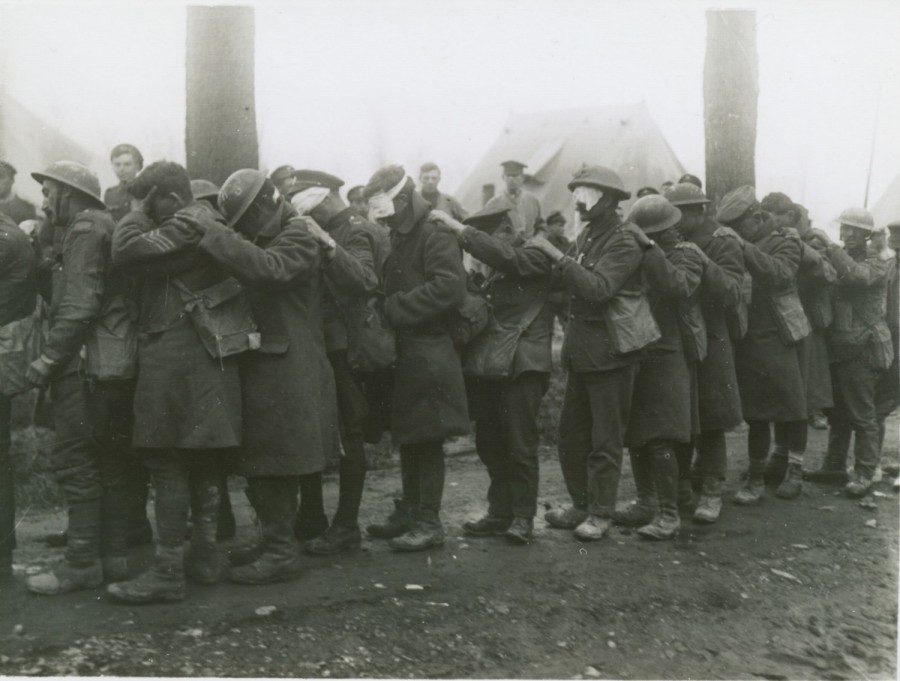
British troops blinded by gas poison
National Archives photo, courtesy of the Indiana War Memorial
The stalemate of WW1 left men caught in trenches for months and months. Gas usage had been considered uncivilized, but the French resorted to its usage in August 1914 in an attempt to rout the Germans. Unfortunately, the Germans were the first to give gas warfare serious development and it became used extensively before the war was over.
The use of poison gas was widely condemned and hurt German relations with the remaining neutral nations. The British roundly criticized the Germans with an extensive propaganda campaign, but gas usage continued to escalate throughout the war. The British rebutted in September of the same year with a gas assault at the battle of Loos. The shifting winds caused their own troops to suffer, with more British affected than Germans. As a result, they switched to the use of artillery shells to disperse the gas assault with more accuracy.
Three primary types of gas were used in WWI:
Lachrymator - tear gas.
This caused temporary blindness and serious irritation to the nose and throat of the victims. It was used more for harassment of troops engaged in close fighting or operating machine guns. A gas mask offered good protection.
"Sag" relieved Poison gas victims
American soldiers in the fighting lines were furnished with tubes of a medicinal paste to cure mustard gas wounds. It was simply smeared over the burned patches or rubbed on the skin to prevent burning. It was called "SAG" which is the reverse spelling of "gas".
"America's War for Humanity", p. 488
Sternutator gasses
Poisonous gas, chlorine, phosgene, and diphosgene. Chlorine gas mixes with moisture so it will attack the eyes and lungs. Phosgene was used in lieu of chlorine. It caused much less coughing in the initial assault and more of it was inhaled causing a delayed effect. Often a soldier could be taken down up to 48 hours after the attack. It was later mixed with chlorine to cause the vapor to be spread more widely and more deadly. It was usually delivered in high explosive shells leaving the troops unable to immediately recognize its presence.
Suffocating gasses
Stories from the Veterans:
Albert S. Bowser, 2nd Lt., Allen County, Indiana, Chemical Warfare Service
Lt. Bowser was gassed at the Long Island City Gas Defense Plant, as were many others, casualties at the plant being numerous and severe, from a chemical accident in the laboratories.
Leland Payne Davis, Corporal, Infantry, Decatur County, Indiana
“On April 4th, 1918, I and about 200 other Indiana boys, mostly from Central Indiana; Indianapolis, Anderson & vicinity, were transferred from the 334th Indianapolis, Regiment to the 130th Reg., 33rd Div. and sailed for France via Hoboken, NY, May 10th, arriving Brest, France, May 16th and within two months was engaged in active work on the front in the Infantry. The Indiana boys in this 33rd Illinois National Guard showed their mettle, as well as the boys from the Sucker State, all that was not noticed, was that we were from the wrong state.
The colors and standard from our Regiment received many decorations from the British, French and Americans, many boys received medals. We served with the British Australian & Canadian Forces on the Somme for three months, then went to the American Front and were actively engaged on that front until March 11, serving with all American Armies.
I was attached to the 2nd Bn., Hdqtrs., as soon as we landed in France, serving as liaison Corporal most of the time.
The taking of Marcheville was our biggest job on November 10th. We lost 48 men and had over 300 wounded. (At least 5 of the 200 Indiana men of the 136th lost their lives and about 50 are wearing one or more wound stripes.”
Corporal Davis suffered mustard gas burns on his lungs and both legs during the Marcheville raid. He participated in the following battles: Class A Major Offensives, Meuse-Argonne (Coteile-Monte Dannevous Qucourt, Sept 25 – October 4th; Bois-de Chaume, Bois Plat-Cheve October 10th & 11th.) 21st of October with the XVIII French Corps on the East bank of the Meuse River.
Class B, Amiens sector with the Australian Corps July 20 – August 6. Albert Sector with the XXVII British Expeditionary Force, Morlancourt, 10 & 11th of August. Albert Dennicourt August 11th – 20th. Verdun sector; La Morle Homme September 23 – 25. Troyon sector, Connecticut sub sector, October 25th – November 12. Raiville St. Huc (illegible) also served in the Army of Occupation from December 12–19, 1918 & April 1 – 14, 1919.
Howard Elliott, Pvt, U.S. Army, Marion County, Indiana
Trained at Camp Greene, Charlotte, North Carolina. Left the first of May, landed on the Southeast coast of England, May 24, 1918. On the fighting line through the month of July 1918, and went over the top Chateau-Thierry, where he lost his hearing and was lightly gassed. He was sent to Base Hospital #68 for treatments for his hearing for six weeks. Not getting much better, he was sent to a prison camp as a prisoner of war guard, where he remained until after the close of the war. He returned home and was honorably discharged from service on February 15, 1919
Estal Napoleon Rhodes, Sergeant, Co. B, 22nd Inf., 42nd Div., Vanderburg County, Indiana
Enlisted in the Army in Bloomington, Indiana. On the second enlistment, October 12, 1916, went to Jefferson barracks for two months then Douglas, Arizona was with the 22nd Infantry Co. B. Was in battle of the Slaughter Ranch, Arizona.
In New York, April 6, 1917, he helped transfer 27 German vessels and 1700 German prisoners. Sent to France on February 3, 1918. Trained for one month and then sent to battle at Chateau-Thierry, for two weeks and then given one week of rest. Sent to Sandman Hieal for two weeks and then M. R. for six weeks, then to the Argonne Forest for 21 days, where he was wounded and lay on the field for 18 hours before being found. He was sent to a US hospital for treatment, then discharged. After arriving home he spent three months at the Marine hospital in Evansville, Indiana.
Wounded, his horse was shot from under while carrying a message. Shot through his arm, he lay in the field for 18 hours and then gassed. Treated in field hospital #113, Argonne, France for broken leg, arm and gas wounds.
Battles: Sandman Heil, March 17, 1918, Chateau-Thierry April 8 through April 28, 1918, Argonne Forest June 17 through July 13, 1918.
Born June 6, 1895 in Boonville, Indiana. Married Lorena Seiphert of Evansville, Indiana.
Professions, Carpenter: Shipping clerk, Advanced Stove Works. Race listed as White & Indian.
WWI photo of the day:
French real-photo postcard of two unidentified army soldiers [believed to be U.S. Army soldiers] posing outside in a portable photographer's studio wearing their World War I gas masks. A hand-painted landscape scenery is seen in the background (Undated).
US Army Signal Corps photo
Melvin A. Rohler, Private, Infantry, Tippecanoe County, Indiana
Entered service September 25, 1918. Stationed at Camp Taylor, Ky., and Camp Shelby, Miss. Saw active service in France and was wounded in the shoulder by machine-gun fire in the battle of Chateau Thierry. Was gassed while at Verdun and also went “over the top” at St. Mihiel. Born at Stockwell, Ind., Nov. 12, 1894; son of John A. and Ada May Robler. Attended Lafayette schools. Home is Stockwell, Ind.
Henry Harold Detweiler, Co. 36, 42nd Army Service Corps, Allen County, Indiana
Born February 19, 1904, in Gladwin County, Michigan
“N. B. thorough investigation establishes beyond a doubt that Henry Harold Detweiler was Allen counties youngest recruit an active soldier.”
Sent to Verdun, with the 42nd Regiment. In the fighting at Coblenz. Hospitalized two or three weeks at Base Hospital #1, and Verneuil. Lungs eaten by gas.
“Young Detweiler enlisted at the age of 13 years, being an overgrown lad, and easily passing for military age. Father did not interfere. (youngest from Allen County). Record excellent, honorably discharged, and immediately reenlisted for one-year service in the United States.” Enlisted in the Motor Transport Corps, Camp Zachary Taylor, Louisville, Kentucky.
Paul Emmett Morgan, Sergeant Major, 13th Cavalry, 2nd Div., Grant County, Indiana
The French distinguished the 2nd Div. for saving Paris. Battles: Verdun, Toul, Chateau-Thierry, Argonne
Wounded : “Shot through the hand and through the leg and gassed by mustered in chlorine gas. My hair was burnt and I could not see for three weeks. Hospitalized in Bordeaux, France.
The 2nd Div. went in the trenches March 17, 1918. The 2nd Div. took a more prisoners than any other Division in France and lost more men than any other Division. The 2nd Div. consisted of 9th & 23rd Infantry and 5th & 6th Marines. I went in the trenches March 17 and was wounded July 26, 1918.
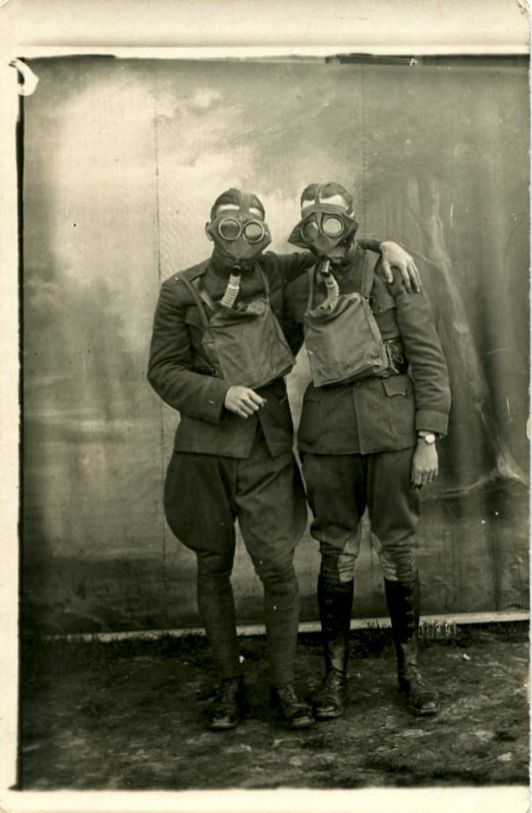
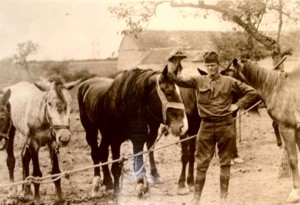
A group of gassed horses being treated by the 302nd Veterinary Mobile Hospital
Photo Courtesy of Indiana War Memorial Archives
Horses were outfitted with gas masks but would suffer damages to their eyes during a gas attack if chlorine or vesicatory gases were used. Their eyes were not affected by the phosgene gases. Equine goggles were designed for them but tended to fog up.
Getting Gas Out of the Trenches:
Protected by a mask and respirator, the soldiers went into the trenches after a gas attack to beat out the heavy gases
Freedom’s Triumph, Photo courtesy of Indiana War Memorial Archives
Source "The Literary Digest History of the World War", volume V, p. 55. Date=1920 Author=Halsey, Francis Whiting,
First published in the USA before 1923.
Various gas masks employed by the nations of the Western Front during the war
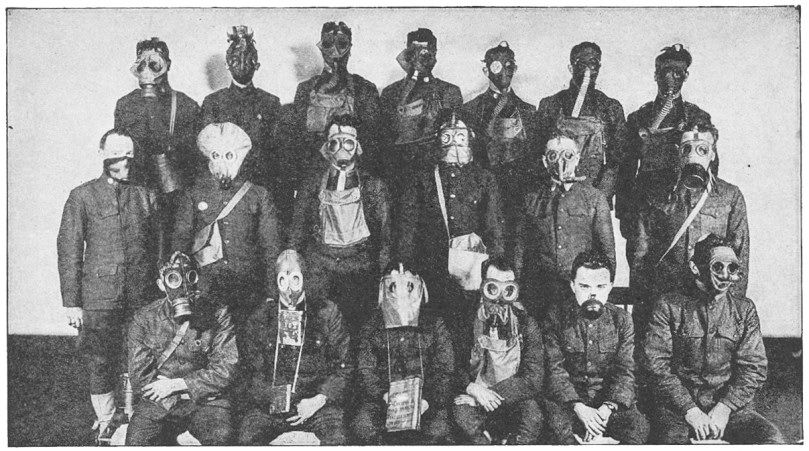
"Captain the Honorable Frederick Shaughnessy, son of the well known Canadian railroad magnate, clearing the bad air from his dugout with the aid of a captured German machine made for this purpose."
America's War for the Humanities
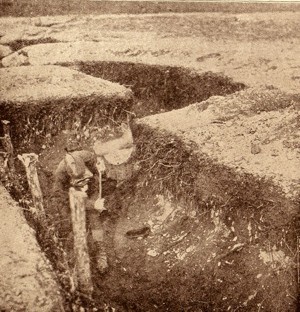
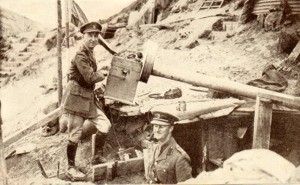
Philip George Hague, Silver Star, Marion County, Indiana
Wounded at Aisne-Marne, gunshot wounds to head and shoulder, October 16, 1917. After four weeks of intensive training, we left for the Sommerville sector in Lorraine to get our first trench warfare, under command of the French. On October 22 and 23rd we were placed near Bathelmount Section on the morning of the 23rd, October, 6:05 a.m. the first shot was fired by Sergeant Arch of One Battery. On November 5th and 6th, 1917 we were relieved by Second Battery and went to Ribecourt to start training with the Infantry of the Div. and on January 18, 1918, we left for Ansauville (Toul) Sector. March 1 we had our first real touch of action. We fired a barrage which lasted 55 minutes, and Battery D. fired 14,842 rounds.
March 5th - 10th, all batteries were subjected to vicious gas from the enemy. On March 28, we were sent to Chaumet-en-Vexin. The Div. took 225 prisoners, and we counted 275 dead Germans in Cantigny, our losses were light, this was in May. On July 4, we had an attack at Cantigny. From July 12, we got ready for the attack at Soissons in which I was wounded on July 20. Left hospital on September 6, and on September 11, we went to Beaumont on the left in the Battle of St. Mihiel. Our next big drive was at the Meuse-Argonne and after two weeks of fighting, we were relieved and started to Coheppy when we got orders to come back and stayed until October 23 and returned again on November 6, 1918, when we were given orders for attacking Sedan. On November 11th, the word came of the signing of the armistice. We then left Bantheville, November 14 and on November 17 we started on the historic march to Germany. On December 1, the Division crossed the Moselle River and on the 13th, just 16th months after our arrival at St. Nazair, we crossed the Rhine. We were with the Army of Occupation until July 25, 1919.
Lawrence Curn Casler, Pfc., Field Artillery, Hamilton County, Indiana
“I was slightly gassed but did not have to go to the hospital until the War was over and they said I could not get a wound stripe. Hospitalized for three months.
St. Die Sector July 28 August 23, 1918, Chappell Offensive August 16 and 17th, 1918, St. Mihiel Offensive September 12 -16, 1918 and Luneville Sector September 16 to November 11, 1918
Carl L. Martin, Private, Marion County, Indiana
Sent to Camp Taylor, October 6, 1918. Sent to Camp Logan, Texas, March 30. Assigned to 131st Regiment, Co. F. Left for overseas, May 15, 1918.“Went into action July 4, was with the Australian string that at the time of this fighting, was in Battalion July 18th. Fought on the Picardy, Flanders, and Argonne fronts. Gassed in the Argonne Forest about October 19th. Was sent to hospital at Vichy, Base Hospital #1, convalescent for two months. Was sent back to his Regiment, on December 25, in a boxcar with very meager food supply, received no pay for seven months, was assigned to 272nd Military Police Co.
The dearest thing to his heart now is home, but maybe an old man before, or if, he gets back at all
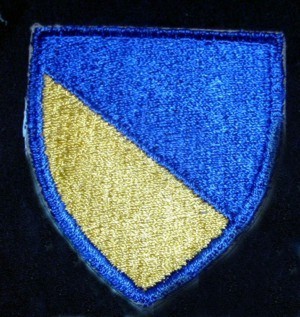
Chemical Warfare Unit Service Patch WW1
Indiana War memorial Archives
Edward James Rimstidt, Infantry, Ripley County, Indiana
“Was slightly gassed at St. Mihiel. Two machine-gun bullets passed through a canister of the gas mask also at St. Mihiel. In this battle, the loader of the gun which Rimstidt was gunner was killed, while lying beneath the gun a piece of shrapnel passing entirely through the lower part of his head. Rimstidt has a piece of shell as a souvenir. It is the ‘nose’ of a shell with the groove. The loader was to have been transferred the day before this occurred but at Rimstidt’s request had been retained.
Harry Ellis Wells, Pfc, Troop A, 1st Indiana Cavalry Vanderburg County, Indiana
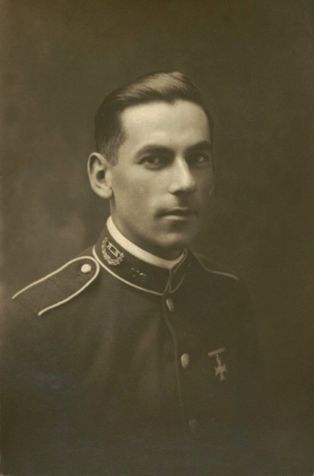
(On letterhead from the Treasury Department, United States Public Health Service, Arrowhead Springs, Calif.)
April 27, 1922
Dear Folks all;
Well if I was to answer in full all of the letters I have on file this would be some letter, but the way I feel now I don't think it will be much of a letter. If I felt good I could write you some letters now as I have a dandy little Underwood Standard Portable Typewriter that a friend brought in for me to use. He bought it new last week and brought it over for me to use and has never taken it home to use himself yet, but he is out and going most of the time. He drives me whenever I want to go anyplace as I don't dare to go out by myself anymore. I wish Lee (his sister) had a machine like this one. It sells for the same price as the Corona but is much better as it is more compact and does not fold up. Anything that does not have joints is generally more solid than that which has.???
I just came up from the picture, had Mable Normand in "Head over Heels" and Davis and I sat through 4 reels of it and had to come back to our room all in sick. We have been sicker the last couple of days than we have ever been, and wish that we had it over with. I am going to have to quit for tonight now, I just got through throwing up supper, what little I forced down me just before I started this letter, so you can imagine how much I feel like writing this night. So I will say good night, as this page is about finished anyhow, sleep tight. "over"
Sergeant John Bush
Letters home from Sergeant John Bush, hospitalized in a VA hospital from the effects of gas poisoning during the war. He died on November 30, 1922, at Arrowhead Springs, The Army Convalescent Hospital in Carona, California.
The following letters are from the family archives.
He weighed 74 lbs. at the time of his death.
Family photo
Knights of Columbus War Activities
Arrowhead Springs, California
Dear Folks all:
It quit raining today and Sun is shining. Sure had some rainstorms here during the last week, guess you read about it? There's only one highway open from here to Los Angeles today, but others will soon be possible.
Here it is 2:15 pm. I felt so bum after dinner that I didn't feel like writing. The sun is out fine now, and we are having typical California weather, so I guess I will probably drive to Los Angeles tomorrow after all, if it is as nice as it is today. I want to attend the Examiner's big Christmas Festival tomorrow (Saturday) night if possible. Are you still raising rabbits? I wanted to get downtown this week to send some fruit to all of you, but could not make it on account of the rain and the awful condition my arms are in. I am so afraid of catching a cold in them and getting blood poisoning, in which case I would soon lose both arms, and then I would be a nice fix? And I suffer enough the way it is anyhow. Oh! Yes! I never told you about the present I bought myself November 19, I bought a 19 jewel Elgin (best make) green gold, 25-year case, a Simons gold chain. I had the 2 1/2 gold piece Lee gave me made up with 5 and 10 gold pieces into a fob. Sure is a beauty, the outfit is worth $80.
Well, I will close for this time. I just wrote Lee a long letter yesterday for all of you, you can send this one over for them to read too.
Love and best to all,
John
Address me “ Arrowhead Springs, California”
Sergeant John Bush, 2nd from Left, in France with unidentified soldiers.
Family photo (Note: Sgt. Bush is my great uncle)
May 17th, 1922 (Ed note: handwritten, this is the last letter the family received. He died November 30, 1922)
This is about the first I have felt like writing since I wrote the other side. I have received all of your letters and sure do appreciate them even if I don't answer them, but I would write if I was possibly was able. I weighed 74 lbs. yesterday, that is the lowest yet. You would not know me at all now if you were to see me, as my face is nothing but bones covered over with a little skin. I hardly ever even look in a glass at myself anymore and my body is absolutely just bones. I lost 4 lbs. last week. I get weighed every Monday, and yet get on my clothes and go out for a drive about every nice afternoon or evening for a 30 or 60-mile drive, but I have another fellow with me to drive most of the time, as I am generally stretched out in backseat on a large comforter and 2 or 3 pillows. It is not so rough riding over these roads as in Indiana or Illinois, as our worst country road here is smoother pavement then the best streets in Indianapolis. And what's more, I'm going to keep on riding until my time comes and I expect to be riding then, and I surely don't think it will be much longer because I am suffering so awful much and losing ground so fast.
Harve (his older brother) coming in the morning, could get here Sunday. I expect to drive back with him for a couple of days. Hope all are well. I am sending papers today for all the old and young ones.
Tell everybody you heard from me because I think every letter will be the last I am able to write.
Love & best wishes to all, from your living skeleton & loving brother, Uncle John
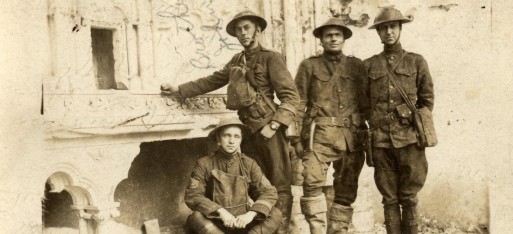
Gas and Flame Attack - National Archives Photo courtesy of Indiana War Memorial
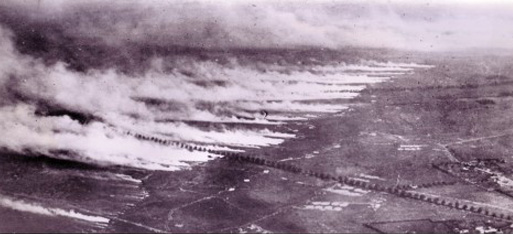
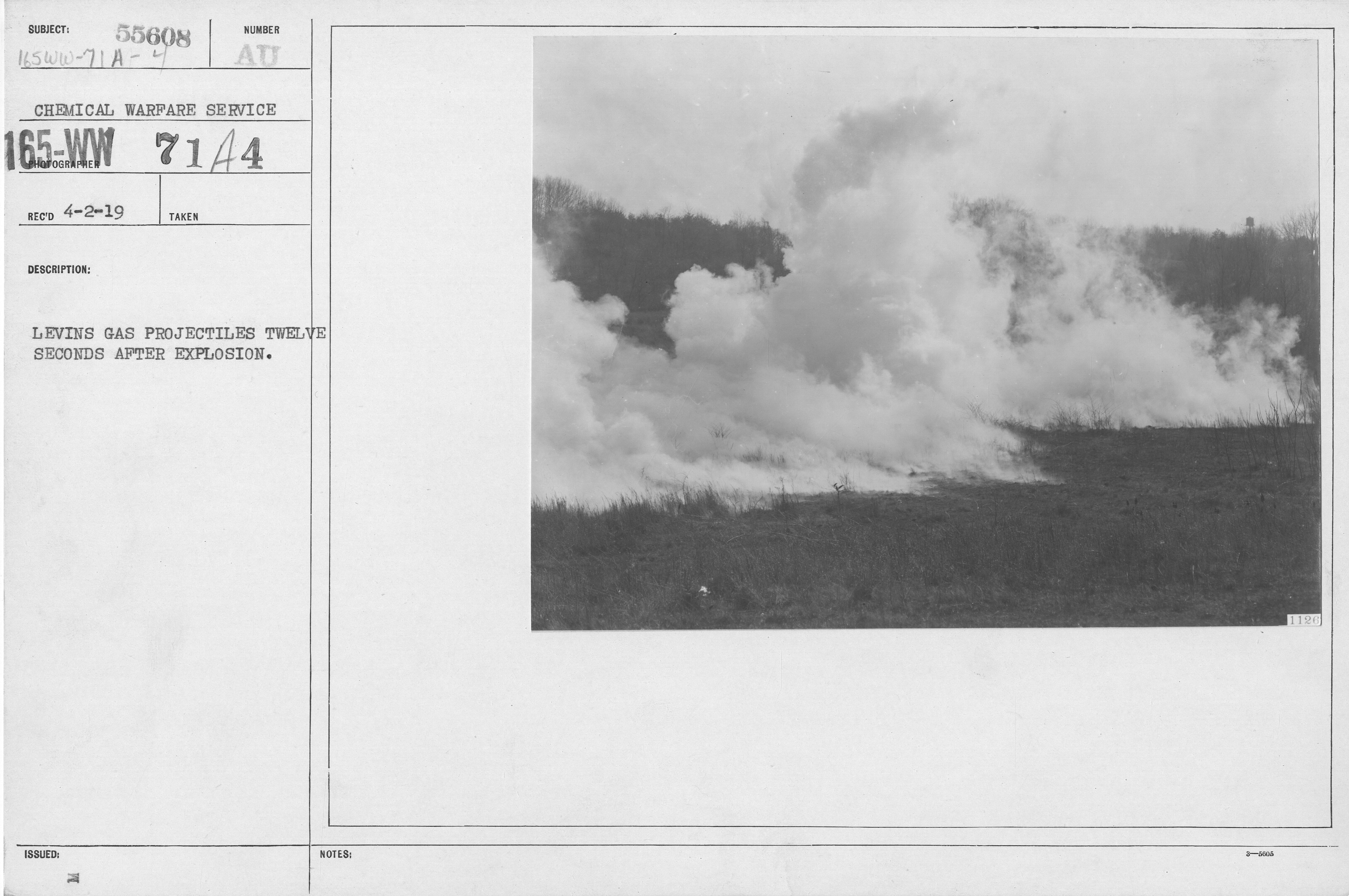
Levins Gas projectile 12 seconds after the explosion
National Archives Photo